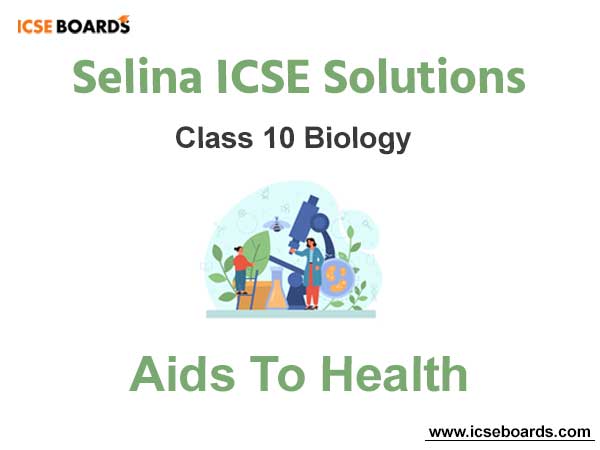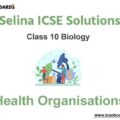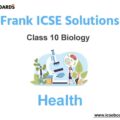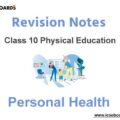A. Multiple Choice Type:-
Question A.1. Penicillin is
(a) an antiseptic
(b) a disinfectant
(c) an antibiotic
(d) an anti-toxin
Solution .
An antibiotic
Question A.2. “T” in DTP vaccination stands for
(a) Tuberculosis
(b) Typhoid
(c) Tetanus
(d) Tonsillitis
Solution .
Tetanus
Question A.3. World Health Day is celebrated on
(a) April 7
(b) February 21
(c) October 10
(d) January 15
Solution .
April 7
Question A.4. DPT stands for
(a) Diphtheria, Polio and Tetanus
(b) Diphtheria, Pertussis and Tetanus
(c) Dysentery, Polio and Typhoid
(d) Diphtheria, Polio and Typhoid
Solution .
Diphtheria, Pertussis and Tetanus
Question A.5. Vaccines are
(a) An extract of toxins secreted by bacteria
(b) An extract of dead and weakened microbes
(c) Strong chemicals obtained from fungi
(d) Chemicals that are applied on the skin to kill bacteria
Solution .
An extract of dead and weakened microbes
Question A.6. The letter “B” in the name BCG vaccination stands for
(a) Brief
(b) Beri-beri
(c) Bacteria
(d) Bacillus
Solution .
Bacillus
B. Very short Answer Type
Question B.1. Name the following:
(a) The drug based on arsenic compound, produced in 1910 which killed germs of syphilis.
(b) The antibiotic that was discovered first.
(c) The category of immunity required in the treatment of snake-bite.
(d) Any four antiseptic any two disinfectants and any two antibiotics in that help to produce immunity against polio.
(d) The vaccine that helps to produce immunity against polio.
Solution B.1.
(a) Salvarson
(b) Penicillin
(c) Passive Acquired Immunity
(d) Antiseptics – Lysol, Iodine, Boric acid and Carbolic acid; Disinfectants – Cresol and Phenol;
Antibiotics – Ampicillin and Penicillin
(e) Oral polio vaccine (OPV)
Question B.2. Write the full form of:
(a) AIDS
(b) BCG
(c) DPT vaccine
(d) WHO
Solution B.2.
(i) Acquired Immuno Deficiency Syndrome
(ii) Bacillus Calmette Guerin
(iii) Diphtheria, Pertussis and Tetanus
(iv) World Health Organisation
Question B.3. Give the technical term from the kind of proteins produced in the bolds to fight and destroy harmful microbes.
Solution B.3.
Immunoglobulins, or antibodies, are created in the bloodstream to fight and destroy dangerous bacteria.
Question C.1. Mention if the following statements ate true (T) or false (f).
(a) Lysol is an antibiotic.
(b) Sweat and tears contain germs-killing substances.
(c) Our body can make only a limited variety of different antibodies.
(d) Salk vaccine is used against tuberculosis.
(e) Treatment by the use of chemicals is known as allopathy.
(f) Alexander Fleming coined the term “antibiotic” for substances like penicillin.
Solution C.1.
(a) Lysol is an antibiotic. False
(b) Sweat and tears contain germs-killing substances. True
(c) Our body can make only a limited variety of different antibodies. False
(d) Salk vaccine is used against tuberculosis. False
(e) Treatment by the use of chemicals is known as allopathy. False
(f) Alexander Fleming coined the term “antibiotic” for substances like penicillin. False
Question C.2. Differentiate between:
(a) Antiseptic and antibiotic
(b) Antiseptic and disinfectant
(c) Disinfectant and deodorant,
(d) Vaccination and sterilization
(e) Active immunity and passive immunity
(f) Innate immunity and acquired immunity
Solution C.2.
(a) An antiseptic is a mild chemical substance that kills germs when applied to the skin, whereas an antibiotic is a chemical substance produced by a microbe that kills or inhibits the growth of disease-causing microbes.
(b) A disinfectant is a strong chemical that is applied to regions and places on the body where germs grow and multiply, whereas an antiseptic is a gentle chemical substance that kills germs when applied to the body.
(c) A disinfectant is a strong chemical that is applied to areas of the body where germs thrive and reproduce, but deodorants are not antiseptics or disinfectants; they are aerosols that are used to conceal an awful smell.
(d) Vaccination is the introduction of any type of dead or weakened germs into the body of a living being in order to develop immunity against the specific disease or diseases, whereas sterilization is the process of eliminating or killing all microbes present on a surface, in a fluid, in medication, or in a compound such as biological culture media.
(e) Active immunity is created by an individual as a result of a past illness or antigen that enters his body spontaneously, whereas passive immunity is provided by an outside source in the form of “readymade” antibodies.
(f) Innate immunity is immunity derived from one’s genetic composition, i.e. it is passed down from one’s parents. It exists in the body without any external stimulus or past illness, whereas acquired immunity refers to a person’s resistance to a disease gained over the course of his life. It could be the product of a past infection or prepared antibodies brought in from the outside.
Question C.3. Name any three vaccines and the diseases for which they provide immunity.
Solution C.3.
1. TAB vaccine for typhoid.
2. BCG vaccine for measles.
3. DTP vaccine for diphtheria, tetanus and whooping cough.
Question C.4. Given below is a table of certain vaccines, the diseases against which they areused and the nature of vaccine. Fill up the gap 1-10.
| Vaccine | Disease (s) | The Nature of Vaccine |
| TAB | 1._______ | 2.________ |
| Salk’s Vaccine | 3. _______ | 4. _______ |
| BCG | 5. _______ | Living weakened germs |
| Vaccines for Measles | Measles | 6. ________ |
| Cowpox Virus | 7. _______ | 8. ________ |
| Toxoids | 9. _______ | Extracts of toxins |
| 10. ______ | Secreted by bacteria |
Solution C.4.
| Vaccine | Disease (s) | The Nature of Vaccine |
| TAB | Typhoid | Killed germs |
| Salk’s Vaccine | poliomyelitis | Killed germs |
| BCG | tuberculosis | Living weakened germs |
| Vaccines for Measles | Measles | Living weakened germs |
| Cowpox Virus | small pox | Living fully poisonous germs |
| Toxoids | Diphtheria | Extracts of toxins |
| Tetanus | Secreted by bacteria |
Question C.5. Given below are the groups of certain substances of particular categories. Mention the category of each group and identify the wrong example in it giving reason.
(a) Lysol, Benzoic acid, DDT, mercurochrome
(b) Formalin, iodine, Lysol, phenol.
(c) BCG, DTP, ATP.
(d) Tears, skin, nasal secretion, HCl (in stomach).
Solution C.5.
(a) Lysol, Benzoic acid, DDT, mercurochrome
Antiseptic: DDT is a wrong example for this category as it belongs to disinfectant which is not good for human skin.
(b) Formalin, iodine, Lysol, phenol.
Disinfectants: Iodine is a wrong example as it is an antiseptic.
(c) BCG, DTP, ATP.
Vaccines: ATP is a wrong example as it is used as an energy carrier in the cells of all known organisms.
(d) Tears, skin, nasal secretion, HCl (in stomach).
Question C.6. Given below is a scheme of classifying immunity against human diseases. Fill up the types of immunity in the blanks 1-9.

Solution C.6.
1. Innate Immunity
2. Acquired Immunity
3. Specific Immunity
4. Active Acquired Immunity
5. Passive Acquired Immunity
6. Natural Acquired Active Immunity
7. Artificial Acquired Active Immunity
8. Natural Acquired Passive Immunity
9. Artificial Acquired Passive Immunity
Question C.7. List any four ways in which antibiotics are being used.
Solution C.7.
(a) Antibiotics are commonly used to treat infections in medicine.
(a) Antibiotics are utilized as food preservatives, particularly in the case of fresh meat and fish.
(c) Antibiotics are sometimes used to treat animal feed in order to prevent internal infections.
(d) Antibiotics are sometimes used to combat plant pathogens.
Question C.8. List the merits if local defense systems.
Solution C.8.
Below are the merits of the Local Defense Systems:
1. These mechanisms are not reliant on previous infection exposure.
2. They work against a wide range of potentially contagious organisms.
3. Local defense systems go into action right away.
Question C.9. Suppose a person develops the diphtheria comment upon the principle of the treatment he should receive.
Solution C.9.
Diphtheria is a life-threatening bacterial infection. It causes a cold, coughing, and sneezing, and if left untreated, it can lead to heart failure or paralysis. Medication and supportive care are used to treat the condition. The most crucial step is intravenous delivery of diphtheria toxoid, which has been rendered harmless. Once injected into the patient’s body, the toxoid causes the body to produce antibodies against the bacteria that cause diphtheria.
Question C.10 What first aid steps would you take in the following cases of accident?
(a) Bleeding from a cut in the skin:
(b) A fractured Arm:
(c) Stoppage of breathing due to electrical shock:
Solution C.10.
(a) Bleeding from a cut in the skin:
1. If bleeding occurs, elevate the afflicted area to reduce blood flow.
2. Use clean water to clean the cut surface.
3. Apply some antiseptic and press the area with a piece of clean cotton.
(b) A fractured Arm:
1. Place the victim in a comfortable position and loosen or remove the clothing from the injured area; do not move the fractured part.
2. If the injured limb is an arm, secure the arm in a sling over the neck.
(c) Stoppage of breathing due to electrical shock:
1. Lie the victim flat on his back with a pillow or folded towel under his shoulders, raising his chest and throwing his head back.
2. Hold his arms upwards and backwards and draw them upwards and backwards. His chest will expand and pull in air as a result of this.
3. Fold the victim’s arms and press them against his or her ribs. The air is about to be evacuated.
4. Repeat the first two steps around 15 times each minute. Continue until the victim begins to breathe on his or her own or until the doctor comes.
Question D.1 The principle of vaccinations is to produce immunity against a disease. Example.
Solution D.1.
Vaccination is the process of introducing germs or germ substances into the body in order to create resistance to specific diseases. Prophylaxis is the medical term for this procedure, and the material that is injected into the body is known as a vaccine. The vaccine or germ material is normally injected into the body, although it can also be taken orally (e.g. polio drops). The vaccination induces lymphocytes to create antibodies against the microorganisms that cause that disease inside the body. Antibodies are a crucial component of our defence system. Their job is to get rid of any undesirable particles that go into the body. Vaccines signal our immune systems to make specific antibodies. As a result, the goal of vaccination is to create disease immunity.
Question D.2. “Abnormally, large number if WBc’s in the blood are usually an indication of some infection in our body.” Comment on the statement.
Solution D.2.
When a germ or pathogen enters the human body. The immune system receives a signal to manufacture specific antibodies. White blood cells multiply rapidly in order to keep up with the amount of pathogens multiplying inside the body. This allows them to create more antibodies and infiltrate infections more quickly. As a result, “abnormally high WBC counts in the blood are usually a sign of an infection in our body.”
Question D.3. Explain briefly, the role of the following health aids:
(a) Antiseptics (b) Disinfectants (c) vaccines
Solution D.3.
(a) Antiseptics:- Antiseptics are chemical agents that serve to prevent infections by slowing or stopping the growth of microorganisms on the body’s exterior surfaces. Iodine are examples of antiseptic.
(b) Disinfectants:- Disinfectants are substances that kill all microorganisms that come into contact with them. Disinfectants are typically too powerful to be used on the human body. Cresol and phenol are two examples.
(c) Vaccines:- Vaccines are given to a person to give them passive immunity. Germs or the chemicals released by germs are the most common materials. Oral Polio Vaccine and Diphtheria, Tetanus and Pertussis (DTP).
Question D.4. Define First aid.
(a) A thorn has punctured the little toe of the foot, causing it to bleed.
(b) An old woman has passed out while strolling on the sidewalk during a scorching midday.
(c) A young boy’s fingertip was burned while firing crackers.
(d) While digging soil in the flower bed, your gardener was bitten by a snake.
Solution D.4.
First Aid:- Before regular medical help can be sought, an ill or injured individual receives emergency care or treatment.
(a) A thorn has punctured the little toe of the foot, causing it to bleed:- If you experience bleeding, elevate the affected area to prevent blood loss due to gravity. If possible, rinse the wound with clean water, press it with clean cotton wool, and use a mild antiseptic.
(b) An old woman has passed out while strolling on the sidewalk during a scorching midday:- During a sweltering midday stroll on the sidewalk, an elderly woman passes out: As soon as possible, get the woman to the side of the road. Remove all of your clothing and loosen it up.
(c) A young boy’s fingertip was burned while firing crackers:- Immediately wash his burned finger in plenty of cool water for a few minutes. Rub the scorched area as little as possible. If prescription creams/ointments are readily available, use them.
(d) While digging soil in the flower bed, your gardener was bitten by a snake:- Squeeze some blood out the wound as soon as possible, then apply a tourniquet to the area to prevent the poison from spreading.





